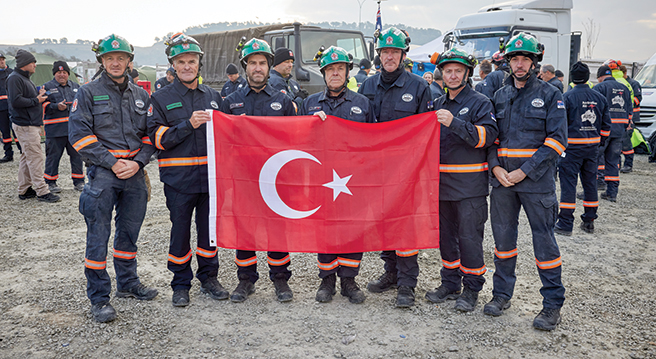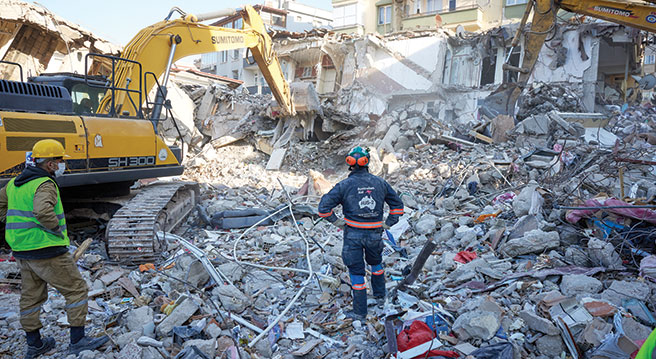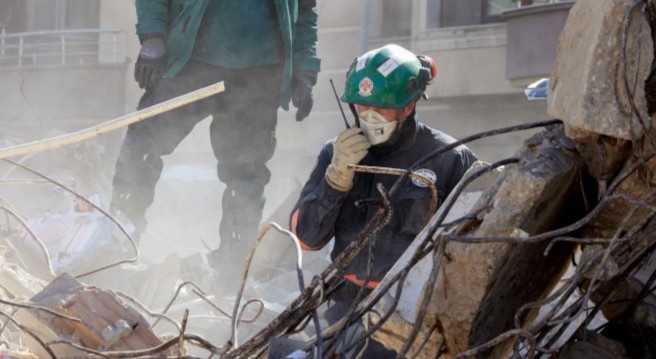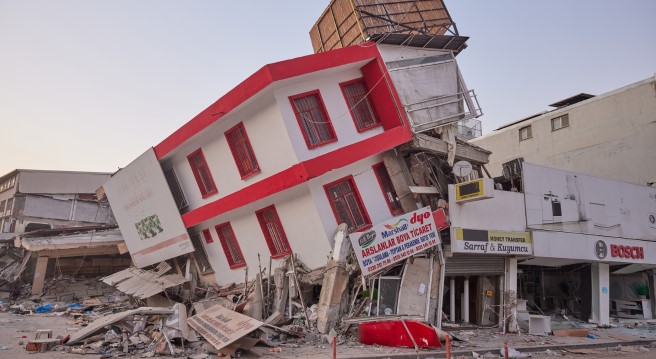
Roads which are no longer roads, buildings that have been “pancaked” and people crying for help as they gather next to their now demolished properties.
This is the tragic environment our team of five Special Operations Team rescue paramedics (Murray Traynor, Steve Green, Scott McNamara, Steve Talbot and Shane Whittaker) and two aeromedical specialist doctors (Dr Robert Scott and Dr Jimmy Bliss) were confronted with on a daily basis during their USAR (urban search and rescue) mission to Hatay Province, Southern Türkiye, as part of Australia’s response team to the devastating earthquake.
Over eight long and challenging operational days, our NSW Ambulance clinicians were tasked with two primary objectives: provide medical support to the 72-member DART (Disaster Assistance Response Team) Taskforce (AUS02) and Search and Rescue, which included the recovery of both living and deceased people trapped in the rubble.
The DART team included personnel from NSW Ambulance, Fire and Rescue NSW, Queensland Fire and Emergency Services, ACT Fire and Rescue, NSW Departments of Health and Public Works, NSW Police, the National Emergency Management Agency and the Department of Foreign Affairs and Trade.

Murray Traynor – the team leader for the NSW Ambulance contingent – said his team realised pretty quickly upon arrival at Hatay that their mission was to be one which would hopefully locate live survivors, but more likely include locating bodies
“The level of devastation was, at first, a bit overwhelming,” he said. “Some streets had been replaced by eight-foot high rubble, while buildings had been ‘pancaked’ – an example of this is a six-storey building becoming four stories because the bottom two stories collapsed underneath the building.
“Our team would come across local people camping outside their addresses pleading with you to dig for their loved ones… and that’s what we did.
“I remember one occasion where a building had collapsed and two or three people were believed to be in one section of it, while two others – including a 12-year-old boy – were in another. We found them, but unfortunately they were deceased. The saving grace however was at least the family members got their loved ones back and could bury their bodies with a bit of dignity, instead of not knowing where they are.”
For most of the days, Murray, as team leader, was stationed at a Base of Operations (BOO) while four DART teams of up to 12 personnel went out to search for survivors and recover bodies.
Each of those teams had one of our paramedics with them. The two NSW Ambulance doctors alternated between providing medical support to the teams in the field and supporting DART members at the BOO.

While it was heartbreaking for the DART team to locate dozens of deceased people during the mission, Murray said each body recovered meant everything to the team and to the loved ones of the victims.
“I’m incredibly proud of the NSW Ambulance paramedics and doctors I worked alongside, as well as the wider DART team,” he said. “Each day they would come back exhausted. This is a group of people who have probably never witnessed anything like this before… but despite the devastation they came across, they remained positive after each day because they understood the importance of providing closure to the families asking for our help. People were incredibly gracious while we were there – they would be stopping our cars just to say, ‘thank you, thank you for coming’.”
While the team was confined to working in the city of Antakya, Dr Jimmy Bliss said the scale of devastation in the city was telling enough of how serious the situation was on a larger, geographical scale.
“Every single building within the area we worked was gone….and then you think about that being amplified many times more in other Türkiye and Syrian cities and provinces” he said. “You see these people living in makeshift shelters and tents, think about it on a wider scale, and realise their circumstances aren’t just a stop-gap. They’re going to be living that way for years, and years and years. To rebuild everything will take decades.”
Jimmy said both himself and Dr Robert Scott were fortunate enough to alternate their roles day-by-day. While at the base, he said a lot of the work included treating the DART team for minor injuries and psychological first aid. The doctors would also liaise with other foreign rescue services on logistics regarding daily taskings.
“For our team to recover people from the rubble and return their bodies to their families was very rewarding,” he said. “That’s something I think most of us will reflect on, as well as the gifting of medical supplies to the Türkiye Medical Association (Türk Tabipleri Birliği; TTB).”

Both Murray and Jimmy said the seven clinicians received incredible support from their fellow DART team members, NSW Ambulance and, specifically, our service’s Incident Management Team (IMT) who would maintain regular contact with the clinicians’ family members to provide welfare checks.
These checks – both during and after the mission – were conducted by a family welfare officer, appointed to the IMT from People and Culture.
David Koop, the State Manager of Health Emergency Response Capability and Counter-Measures, worked in the IMT’s Logistics cell, as well as the Planning and Intelligence cell (which he shared with Tony Bishenden, Acting Manager Special Operations).
David had a particularly crucial role in the operation. David, along with State Logistics Officer Craig McLachlan, oversaw the deployment of the medical cache and the seven personnel who went to Türkiye.
The medical cache included a range of medical equipment and drugs that could be used by our paramedics and doctors to treat members of the USAR taskforce, along with any survivors found during rescue operations.
‘I’ve worked at NSW Ambulance for 20 years and have had the opportunity to assist in the deployment of medical caches (and personnel) to several overseas locations (namely the 2004 Boxing Day Tsunami in Indonesia and the 2011 Christchurch Earthquake),” he said.
“Over many years, we have received a lot of good feedback from clinicians, which has helped us to strengthen the systems we have in place for the deployment of medical caches. We’ve also continued to strengthen the relationships we have with other stakeholders involved in these major operations (for example, Fire and Rescue NSW, Australian Defence Force and hospitals).”
David said he was also proud to play a role in the thousands of dollars’ worth of drugs and medical equipment donated to the TTB – following approval from DFAT – at the end of the mission.
“It’s really good to be able to leave a positive, lasting legacy in Türkiye,” he said. “Gifting is a really important part of what we do. We are supposed to leave the country better than when we arrived; and I would like to think we have done this.”
